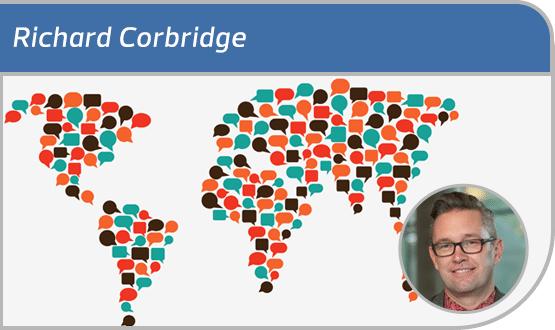We need a shared digital language if integrated care is to become a reality
- 23 March 2018

When holidaying in the US, Richard Corbridge was confronted with the classic problem of two countries separated by a common language. It’s a situation he also sees in digital health – and the chief digital and information officer at Leeds Teaching Hospitals NHS Trust argues it must be addressed if integrated care is to become a reality.
On a recent holiday in the USA, we were chatting about why foods are called different things in different countries. Why zucchini rather than courgette? Egg plant rather than aubergine? Chips instead of crisps, or fries instead of chips?
The only explanation we could come up with was timing. These food stuffs were perhaps discovered at around the same time across the world and therefore no name was ever right or wrong, just more timely and geographically rich.
But these differences speak to the single largest challenge that faces our digital health menu today: interoperability and integration.
The need to be multi-lingual
When we talk about the delivery of a new healthcare paradigm we speak of the delivery of integrated care, with no organisational boundaries and the patient at the centre. But to achieve this requires information to mean the same thing to all those involved in its delivery.
The journalist Geoffrey Williams once said: “You can’t understand one language until you understand at least two.” Johann Wolfgang von Goethe went even further claiming: “He who does not know foreign languages does not know anything about his own.”
Moving healthcare delivery to a system-wide approach is the goal of over 50 (locally driven) digital initiatives in the NHS alone. And the goal of an integrated health and care record is to provide access to, and translation of, multiple care languages. But it is a challenge.
The Hampshire, Ireland and Leeds examples
In the late 1990s Hampshire became ‘famous’ for the delivery of an exemplar record sharing environment, linking access to information recorded in the ‘Exeter System’ – a database of all patients registered with an NHS GP in England and Wales – to information in GP systems.
The largest issue that stunted growth of this early pilot though was the quality of the data and the ability to index the information. The need for a common identifier across health systems was raised and the NHS Number – not for the first or last time – mandated by a target date.
Jumping forward to 2017, the Irish health system delivered a unique EU-wide identifier for the delivery of healthcare to its citizens. Huge effort was put into delivering this in an agile manner at a limited cost. Today the number exists and is available but its actual implementation in healthcare delivery itself remains very patchy.
The Leeds Care Record, meanwhile, enables integration at a level beyond almost anywhere else in the NHS. Over 35 systems are able to share information in a controlled, secure and legitimate fashion. But it only works for the geography of Leeds, and so this isn’t integration, this is interoperability. Information is shared through the same platform but the reference points for the delivery of care remain in the same ‘language’ of the originating care setting. The reliance is on the interpreter and their own understanding of the information.
The culture problem
So how can we truly create an interoperable healthcare system which digital supports; in which there is a shared language? Addressing culture will play a huge part. In this book Culture, Terry Eagleton uses the example of the postbox – an original integration tool – to explore how culture can lead to the flouting of standards. Ireland’s green postboxes denote something different to the gold ones that are the legacy of the London Olympics, he points out.
As quickly as we can, we need to agree nationally (and why not even globally) if we are to achieve integrated or interoperable healthcare systems. The standards to do this exist in so many ways already. Digital health doesn’t need changes to be made at the mega-vendor level – the systems need to adopt the standards and then innovate to exist in a ‘system of systems’ approach.
Building a joint understanding
Eagleton speaks of four areas that he believes are most relevant to creating the right culture: values, customs, beliefs and symbolic practices. Maybe we need to use these to help build a joint understanding of where we need to get to on data in healthcare.
- Values: The value of having integrated care has been made clear for decades. Digital leaders are still at the begging bowl though, seeking funding to deliver the necessary platforms that are required to enable information sharing. With information becoming ever more complex, value needs to be placed on the innovation needed to achieve a truly interoperable healthcare system.
- Customs: Local customs need to be protected but somehow we need to move from the clinical system paradigm. You know the one: where the clinician you have engaged loves the idea of a single system across the hospital, but their additional special system still needs to be protected as well.
- Beliefs: We need the healthcare system to stand up for the belief it has in the delivery of integrated care. That belief will drive the ultimate understanding of what a system of systems digital solution can provide.
- Symbolic practices: Perhaps in the NHS this is about to happen with the launch of the Local Health and Care Record Exemplars funding and a platform to enable lessons to be learned, standards to be tested at local levels, and a real drive from the centre and from the ‘spokes’ to truly achieve this.
There has to be a hook to the original Bevan statement about the creation of the NHS: “Healthcare free at the point of contact”. Now we need data ‘free’ at the point of contact and this can only be achieved if we all have the same reference points.
Now, can I get some fries…? I mean chips… I mean crisps…





6 Comments
The more I look at things, the more problems are caused by the fragmented nature of the NHS. Multiple initiatives, multiple suppliers, multiple competing politics. It’s holding the NHS back from innovating both in what they do operationally, and in tech.
One of the depressive things for me is the endless different initiatives happening across the country, all trying to achieve the same thing, London being a prime example of at least 5 initiatives. Local politics playing a part perhaps? No worry about duplicating costs?
At a basic level the nouns of healthcare appear to work and provide sound building blocks on which more complex integrations can be built. Leeds Care Record (and many US EPR providers) use these already – FHIR ( Leeds care record is not 100% FHIR but close enough).
As a techie it explains health models to me, I can begin to understand what a care plan is, what interactions and goals are and how they relate. It’s still difficult to understand what a HCP is after, but with an understanding of nouns of healthcare (fhir) it is a lot easier.
could start by using the term treatment function instead of specialty, integrated care is provined by by many professions, not just the clinical profession
This should have been sorted out in the last decade, but manufacturers have been reluctant to depart from their proprietary systems. Who remembers the early days of CT, where scans could only be viewed on their proprietary workstations? Now look at what standardisation using DICOM et al has done for interoperability.
Most of the standards exist – it’s just the will to persuade the suppliers to FULLY adopt them.
Pioneers like David Clunie and Neelam Dugar have been pushing for this for years [if not decades] with some success, but more progress needs to be made.
Interesting to see an article that highlights all the issues that we have with current systems without the planned solution, SNOMED CT. 30 member countries and counting including most if not all of those mentioned.
Comments are closed.